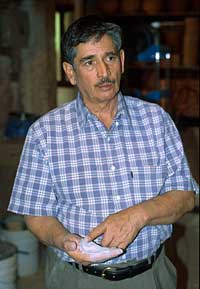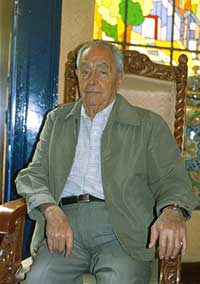|

Talavera de la Reyna
 Angélica
Moreno R. Angélica
Moreno R.
Owner, Talavera de la Reyna
Cholula, Mexico
Photo by Barbara Mauldin, 2001
Angélica Moreno owns and directs Talavera de la Reyna,
a taller of 35 employees that has been in business
for over a decade. Moreno, one of the few women to own and
operate a taller in Puebla, learned about the mayólica
tradition from her uncle. She began this enterprise with three
employees, a tornero (thrower), an esmaltador
(glazer) and a pintor (painter). Though a relatively
new taller, Moreno’s workshop was one of the original
10 to found the Consejo Regulador de Talavera, an accredited
organization designed to support the work of artists working
in the traditional mayólica technique. Although
primarily interested in producing high-quality traditional
ceramics, Moreno has also opened up her facilities to contemporary
artists interested in experimenting in mayólica.
Alfarería Tradicional, S.A.
 Gorky
González, Sr. Gorky
González, Sr.
Owner, Alfarería Tradicional, S.A.
Guanajuato, Mexico
Photo by Feliza Medrano, 2000
Gorky González, the son of a sculptor and antiques
dealer, was surrounded by historic ceramics from an early
age. His interest in sculpture and smelting eventually led
him to experiment first with ceramic molds and then with the
wheel. In the late 1960s, González received a grant
to study ceramics in Japan under the direction of renowned
masters Tsuji Seimei, Kei Fujiwara, Kato Kobe and Kiosuke
Fujiwara. There he met his wife, Toshiko. After returning
to Guanajuato, he pursued his goal of reviving the traditional
mayólica industry. The mark on the pieces from
Alfarería Tradicional "A.T.," reflects González’s
philosophy that this is not the work of an individual, but
a team enterprise.
La Trinidad
 Jorge
Guevara Jorge
Guevara
Owner, La Trinidad
Puebla, Mexico
Photo by Barbara Mauldin, 2001
Jorge Guevara’s aunts and uncle, Concepción,
Margarita, Ramona and Liborio Guevara opened a shop in Puebla
called La Trinidad in 1937. Their family had run a mayólica
shop in the 18th century and their father, Vicente Guevara,
had discovered some old family papers that contained recipes
for mixing the glazes and pigments. He started experimenting
with these and began making mayólica as a hobby.
Soon his children were learning the techniques from him and
in 1937 they began selling their work commercially. La Trinidad
soon gained a reputation for producing beautiful work. Today,
their descendant, Jorge Guevara, maintains the historic building
in which La Trinidad was housed and continues a small, family-run
taller. He oversees the operation and bases his designs
on those that were used by his ancestors.
Uriarte
 Isauro
Uriarte Isauro
Uriarte
Former owner, Uriarte Talavera
Puebla, Mexico
Photo by Barbara Mauldin, 2001
Isuaro Uriarte’s great grandfather, Ygnacio Uriarte
established the Fábrica de Loza de Talavera in 1824.
Since then, the taller, that has now taken the family
name, has been a leader in the revitalization of traditional
Puebla mayólica. Uriarte was one of only five
talleres still operating in the late 19th through early
20th centuries when Dimas Uriarte, and later his son Isauro,
formed a partnership with Spanish artist Enrique Luis Ventosa.
Together they began to expand their repertoire with new styles
and patterns that included pre-Columbian motifs as well as
influences from the contemporary art nouveau movement. Today,
the Uriarte workshop produces pieces that are predominantly
historically inspired but that go beyond the historical prototypes
in their bright palette and exuberant design. Isauro Uriarte
continues to oversee quality and production at the workshop.
|